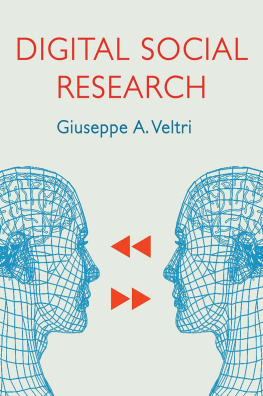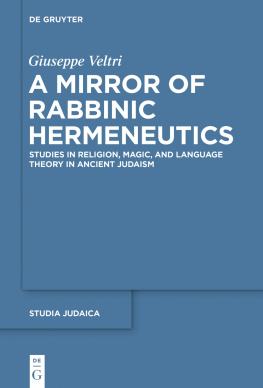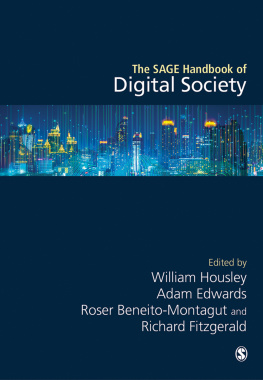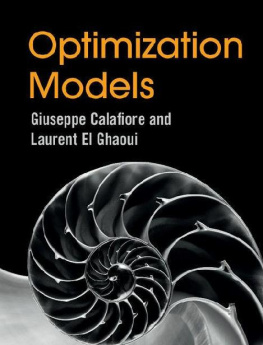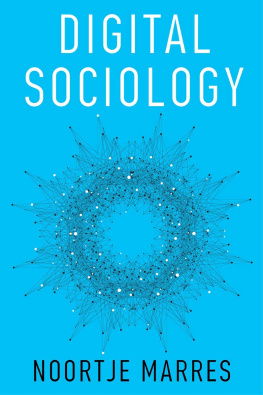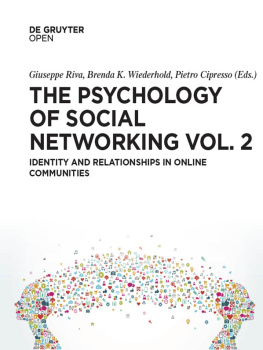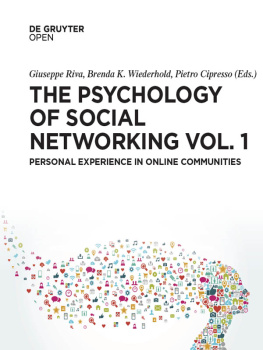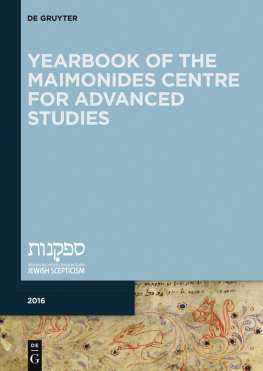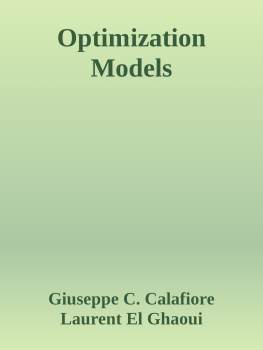Veltri Giuseppe A. - Digital Social Research
Here you can read online Veltri Giuseppe A. - Digital Social Research full text of the book (entire story) in english for free. Download pdf and epub, get meaning, cover and reviews about this ebook. year: 2019, publisher: John Wiley & Sons, Inc., genre: Politics. Description of the work, (preface) as well as reviews are available. Best literature library LitArk.com created for fans of good reading and offers a wide selection of genres:
Romance novel
Science fiction
Adventure
Detective
Science
History
Home and family
Prose
Art
Politics
Computer
Non-fiction
Religion
Business
Children
Humor
Choose a favorite category and find really read worthwhile books. Enjoy immersion in the world of imagination, feel the emotions of the characters or learn something new for yourself, make an fascinating discovery.
- Book:Digital Social Research
- Author:
- Publisher:John Wiley & Sons, Inc.
- Genre:
- Year:2019
- Rating:3 / 5
- Favourites:Add to favourites
- Your mark:
- 60
- 1
- 2
- 3
- 4
- 5
Digital Social Research: summary, description and annotation
We offer to read an annotation, description, summary or preface (depends on what the author of the book "Digital Social Research" wrote himself). If you haven't found the necessary information about the book — write in the comments, we will try to find it.
Digital Social Research — read online for free the complete book (whole text) full work
Below is the text of the book, divided by pages. System saving the place of the last page read, allows you to conveniently read the book "Digital Social Research" online for free, without having to search again every time where you left off. Put a bookmark, and you can go to the page where you finished reading at any time.
Font size:
Interval:
Bookmark:
- Abbott A. D. (2001). Time Matters: On Theory and Method. Chicago, IL: University of Chicago Press.
- Abernathy, D. (2017). Using Geodata and Geolocation in the Social Sciences:Mapping our Connected World. Thousand Oaks, CA: Sage.
- Achen, C. H. and Bartels, L. M. (2017). Democracy for Realists: WhyElections Do Not Produce Responsive Government. Princeton, NJ: Princeton University Press.
- Acquisti, A., Brandimarte, L. and Loewenstein, G. (2015). Privacy and human behavior in the age of information, Science, 347(6221): 509e514.
- Adami, E. (2014). Whats in a click? A social semiotic framework for the multimodal analysis of website interactivity, Visual Communication, 14(2): 133153.
- Alferes, V. R. (2012). Methods of Randomization in Experimental Design. Los Angeles, CA: Sage.
- Alvarez, R. M. (2016). Computational Social Science. Cambridge: Cambridge University Press.
- Andersen, T. H., Boeriis, M. and Maager (2015). Social Semiotics. KeyFigures, New Directions. London: Routledge
- Anderson, T. W. and Herman, R. (1956). Statistical inference in factor analysis, in Proceedings of the Third Berkeley Symposium on Mathematical Statistics and Probability, vol. 5: Contributions to Econometrics, Industrial Research, and Psychometry. Berkeley: University of California Press. Available at: https://projecteuclid.org/euclid.bsmsp/1200511860.
- Angrosino, M. V. (2007). Naturalistic Observation. Walnut Creek, CA: Left Coast Press.
- Armstrong, J. S. (2007). Significance tests harm progress in forecasting, International Journal of Forecasting, 23(2): 321327. Available at: https://doi.org/10.1016/j.ijforecast.2007.03.004.
- Arnaboldi, V., Conti, M., La Gala, M., Passarella, A. and Pezzoni, F. (2016). Ego network structure in online social networks and its impact on information diffusion, Computer Communications, 76: 26-41.
- Aronson, E., Phoebe, C., Ellsworth, J., Carlsmith, M. and Gonzales, M. (1990). Methods of Research in Social Psychology, 2nd edn. New York: McGraw-Hill.
- Barabsi, A.-L. (2003). Linked: The New Science of Networks. Cambridge, MA: Perseus.
- Barabsi, A.-L. and Albert, R. (1999). Emergence of scaling in random networks, Science, 286: 509512.
- Barabsi, A.-L. and Posfai, M. (2016). Network Science. Cambridge: Cambridge University Press.
- Barrio, P. and Gravano, L. (2017). Sampling strategies for information extraction over the deep web, Information Processing and Management, 53(2): 309331. Available at: https://doi.org/10.1016/j.ipm.2016.11.006.
- Bartholomew, D. J. (2002). The Analysis and Interpretation of MultivariateData for Social Scientists. Boca Raton, FL: Chapman and Hall.
- Bastian M., Heymann, S. and Jacomy, M. (2009). Gephi: An open source software for exploring and manipulating networks, International AAAI Conference on Weblogs and Social Media.
- Batagelj, V. and Mrvar, A. (2014). Pajek Program for Large Network Analysis. Available at: http://vlado.fmf.uni-lj.si/pub/networks/doc/pajek.pdf.
- Batinic, B., Reips, U. and Bosnjak, M. (eds) (2002). Online Social Sciences. Seattle, WA: Hogrefe and Huber.
- Bauer, C. and Scharl, A. (2000). Quantitative evaluation of website content and structure, Internet Research: Electronic Networking Applications and Policy, 10: 3143.
- Bauer, M. W. (2000). Analysing noise and music as social data, in M. W. Bauer and G. Gaskell (eds), Qualitative Researching with Text, Image and Sound. London: Sage.
- Bauer, M. W. and Gaskell, G. (2010). Qualitative Researching with Text, Image and Sound. London: Sage.
- Berk, R. A. (2006). An introduction to ensemble methods for data analysis, Sociological Methods and Research, 34(3): 263295.
- Berry, M. W. and Kogan, J. (2010). Text Mining: Applications and Theory. Chichester: Wiley.
- Bethlehem, J. G. and Biffignandi, S. (2012). Handbook of Web Surveys. Hoboken, NJ: Wiley.
- Birnbaum, M. H. (2004). Human research and data collection via the internet, Annual Review of Psychology, 55: 803832.
- Birnbaum, M. H. (ed.) (2009). Psychological Experiments on the Internet. San Diego, CA: Academic Press
- Blei, D. M., Ng, A. Y. and Jordan, M. I. (2003). Latent Dirichlet allocation, Journal of Machine Learning Research, 3: 9931022.
- Bloor, M. (1997). Techniques of validation in qualitative research: A critical commentary, in G. Miller and R. Dingwall (eds), Context and Method in Qualitative Research. London: Sage.
- Borgatti, S. P., Brass, D. J. and Halgin, D. S. (2014). Social network research: Confusions, criticisms, and controversies, Research in the Sociology of Organizations, 40: 129.
- Bornholdt, S. and Schuster, H. G. (2006). Handbook of Graphs and Networks:From the Genome to the Internet. Hoboken, NJ: Wiley.
- Boyatzis, R. E. (1998). Transforming Qualitative Information: ThematicAnalysis and Code Development. Thousand Oaks, CA: Sage.
- Breiman, L. (2001). Statistical modeling: The two cultures, Statistical Science, 16(3): 199231.
- Bronfenbrenner, U. (1977). Toward an experimental ecology of human development, American Psychologist, 32: 513531.
- Brooks, T. and Marsh, E. (1999). The Complete Directory of PrimeTime Network and Cable TV Shows, 1946Present, 7th edn. New York: Ballanti.
- Brunswik, E. (1943). Organismic achievement and environmental probability, Psychological Review, 50: 255272.
- Bryman, A. (2006). Integrating quantitative and qualitative research: How is it done? Qualitative Research, 6(1): 97113.
- Caliandro, A. and Gandini, A. (2016). Qualitative Research in DigitalEnvironments: A Research Toolkit. London: Routledge.
- Callegaro, M., Lozar, M. K. and Vehovar, V. (2015). Web Survey Methodology. Los Angeles, CA: Sage.
- Campbell, D. T. (1957). Factors relevant to the validity of experiments in social settings, Psychological Bulletin, 54(4): 297312.
- Campbell, D. T. (1969). Ethnocentrism of disciplines and the fish-scale model of omniscience, in M. Sherif and C. W. Sherif (eds), Interdisciplinary Relationships in the Social Sciences. Hawthorne, NY: Aldine.
- Campbell, D. T. and Fiske, D. W. (1959). Convergent and discriminant validity by the multitraitmultimethod matrix, Psychological Bulletin, 56: 81105.
- Campbell, D. T. and Stanley, J. (1966). Experimental and Quasi-ExperimentalEvaluations in Social Research. Chicago, IL: Rand McNally.
- Carley, K. (1993). Coding choices for textual analysis: A comparison of content analysis and map analysis. Social Methodology, 23: 75126.
- Castellano, C., Vilone, D. and Vespignani, A. (2003). Incomplete ordering of the voter model on small-world networks, Europhysics Letters (EPL), 63(1): 153158.
- Centola, D. (2010). The spread of behavior in an online social network experiment, Science, 329(5996): 11941197.
- Christian, L. M., Dillman D. A. and Smyth J. D. (2007). Helping respondents get it right the first time: The influence of words, symbols, and graphics in Web surveys, Public Opinion Quarterly, 71: 113125
- Chung, C. J. and Park, H. W. (2010). Textual analysis of a political message: The inaugural addresses of two Korean presidents, Social Science Information, 49(2): 215239.
- Cioffi-Revilla C. (2013). Introduction to Computational Social Science: Principles and Applications. London: Springer.
- Claverie-Berge, I. (2012). Solutions Big Data IBM
Font size:
Interval:
Bookmark:
Similar books «Digital Social Research»
Look at similar books to Digital Social Research. We have selected literature similar in name and meaning in the hope of providing readers with more options to find new, interesting, not yet read works.
Discussion, reviews of the book Digital Social Research and just readers' own opinions. Leave your comments, write what you think about the work, its meaning or the main characters. Specify what exactly you liked and what you didn't like, and why you think so.

